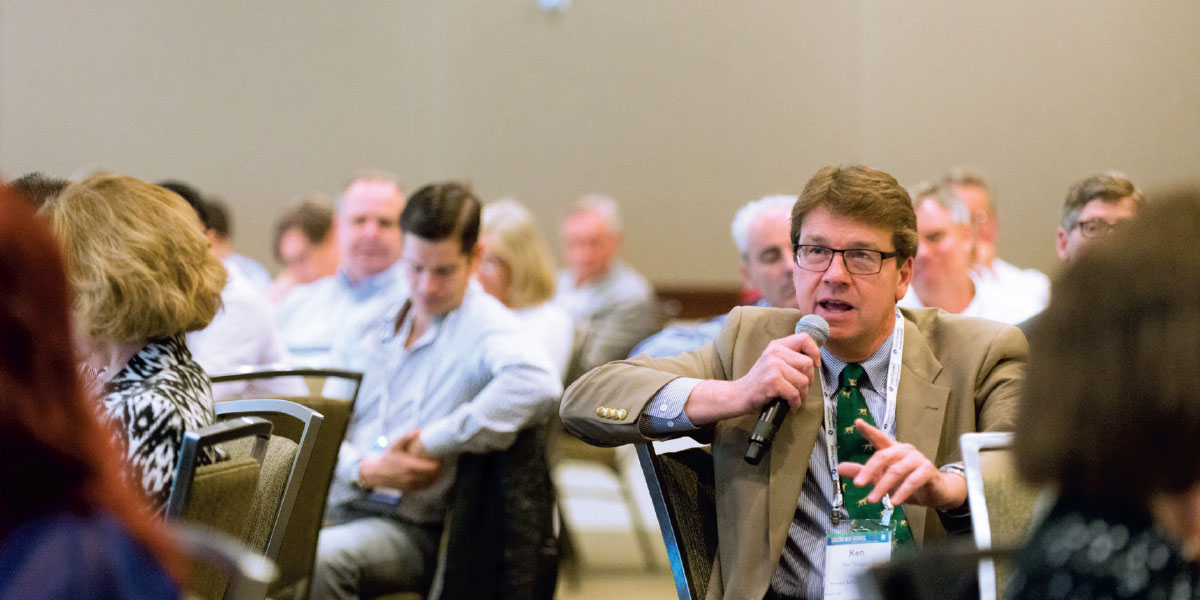
ACADEMIC MEDICAL CENTERS
Prescription for Sustainability
Academic Medical Centers in a Rapidly Changing Environment was a new half-day program designed for university leaders and representatives of rating agencies and financial institutions. In several sessions, participants explored the complex interplay of the educational, research, and clinical activities of medical centers.
Panelists represented medical centers at Rutgers, the State University of New Jersey; the Ohio State University; Washington University in St. Louis; Morehouse School of Medicine; University of Washington Medicine; and the University of Kentucky College of Medicine.
In the session “Transforming Financial Strategies for Academic Medical Centers,” panelists considered how to achieve a sustainable financial model in light of declining federal support for research, varied governance structures, and the different cultures of the university and the hospital.
Financial sustainability under the Affordable Care Act is a looming question for these centers. “Are we able to move from a fee-for-service model to a global at-risk model?” asked panelist John Augustine of Barclays Capital. “If you’re taking care of a population of people, you’re at risk under the ACA.” In many cases, panelists said, the medical center is the primary health-care provider within a region.
“The research grant level is no longer feasible,” said Barbara Feiner, vice chancellor for finance and CFO at Washington University in St. Louis. “Now we’re relying more on philanthropy, foundations, and commercial sources.” Other challenges include university governing boards unfamiliar with health care, greater emphasis on measurable outcomes, expanding affiliations to partner hospitals, and managing risk.
A second session, “Leading Organ-izational Change in Academic Medical Centers,” focused on the regulatory and policy framework as well as strategies medical centers can use to better position themselves for change. Attendees also took part in breakout discussions and a networking lunch.
SERVING THE STUDENT
Strategic Planning Yields Results
In this track were sessions covering new strategies to increase net tuition revenue, gain more efficiencies from a student information system, and more.
When Prevention Is the Best You Can Do
Online financial aid fraud may be increasing simply because of the ease of access to online programs. Higher education institutions need to be proactive and stay ahead of the fraudsters, said speakers at a session “Designing a Proactive Financial Aid Fraud Prevention Plan.”
Vickie Frederick, assistant vice president and assistant treasurer, Webster University, has dealt with financial aid fraud at her institution. Her tips:
- Involve multiple offices and create a red flag plan. Train staff to keep an eye on what looks like an “odd activity,” such as a student’s overly aggressive pursuit of a refund.
- Be proactive. Fraudsters are looking to make fast money and will adapt to your system quickly.
- Review low online activity reports. Typically, fraudsters will log in to participate in an online class, but will put in the least amount of activity.
Matthew Wester, partner, Rubin Brown’s Corporate Finance and Forensic Services Group, added that institutions have a responsibility to use the government funds correctly. They need to make fraud prevention a priority and establish a cross-functional task force that meets regularly and not just when required.
Shaping the Entering Class
With a discount rate well below the national average, realized enrollment targets, and a diversified student body, Loyola University Maryland, Baltimore, seems to have it all figured out. Presenters from the university shared details in the session “Enrollment Strategies That Maximize ROI and Deliver the Class You Want.”
Marc Camille, vice president for enrollment and management and communication, encouraged the audience to be innovative and entrepreneurial in their thinking, since “your competitors will be doing what you are doing next year.” The key: knowing where your admitted students are going if they aren’t enrolling at your institution.
Loyola University Maryland has found a balance between what Camille calls “the things you have to do (expenses) and the things you want to do (investments).” The institution has found that reaching out to high school sophomores has been an effective way to be “on the radar” of students earlier.
To E-Transcript or Not to E-Transcript
Why aren’t student transcripts being shared electronically in this day and age? The session titled “The Case for Electronic Transcripts” showcased a collaborative effort by NACUBO, the American Association of Collegiate Registrars and Admissions Officers (AACRAO), and Parchment Inc., to study current transcript practices and costs.
A recent survey of colleges and universities showed that paper is still by far the predominant method for sending and receiving postsecondary transcripts, with PDF format a distant second and EDI/XML format still lower. This is the case even though paper is clearly the most costly. But, “we can make admissions decisions automatically with electronic high school transcripts,” noted Wendy Kilgore of AACRAO Consulting.
Institutional concerns include security of the information as well as the need for agreements with partner institutions to implement an e-transcript solution. Actually, said Gretchen Hanson, product marketing manager for Parchment Inc., “fraud is more likely with paper. You can trust electronic data, as the banking industry does.”
Change will require a transformative leader to champion the cause, Hanson said, as well as an institutionwide culture shift. “We saw the FAFSA go electronic several years ago. And how long did it take for institutions to adopt purchasing cards?”





